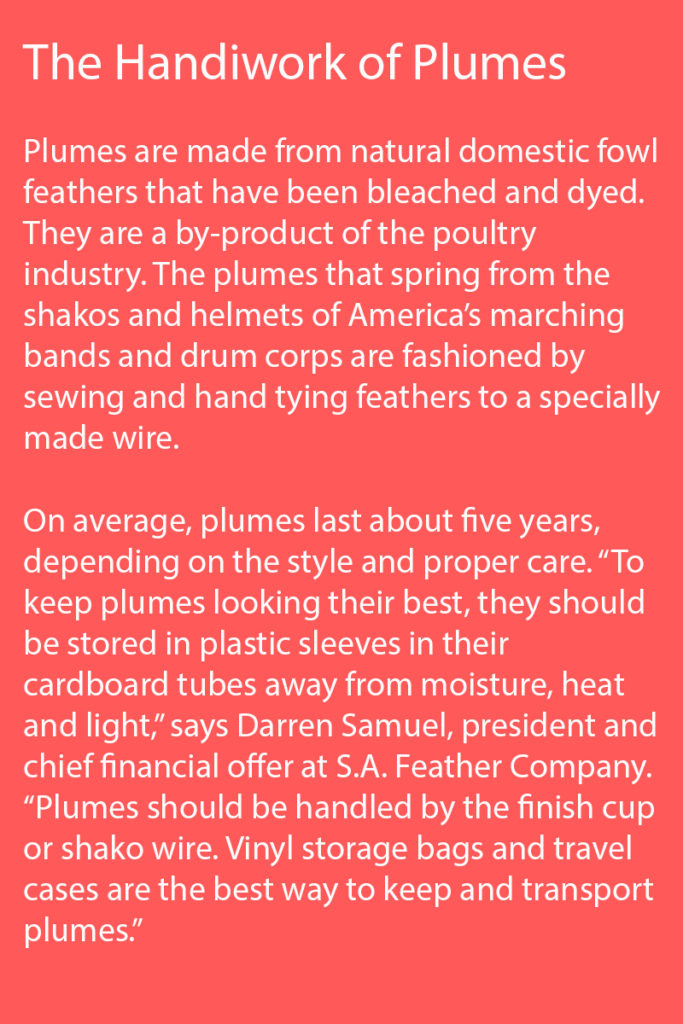As marching shows and uniforms have changed over the years, so too have plumes. Mainly white or black in the past, now plumes seem endlessly customizable to match the latest fashion and to surprise audiences.
 There’s no doubt about it—Yankee Doodle was a dandy. Never afraid to take a fashion risk and excessively conscious about his appearance, he stuck a feather in his cap because he knew the plume was an integral accessory of the 18th-century male wardrobe.
There’s no doubt about it—Yankee Doodle was a dandy. Never afraid to take a fashion risk and excessively conscious about his appearance, he stuck a feather in his cap because he knew the plume was an integral accessory of the 18th-century male wardrobe.
In Europe it would be hard to imagine d’Artagnan and The Three Musketeers swashbuckling through Paris and beyond without outrageously large plumes flowing from their hats.
For generations the plume has adorned the shakos and helmets worn by America’s marching bands and drum corps. Once an afterthought, like the candles on a birthday cake, today the plume adds a bit of drama but also serves a purpose.
Form and Function
Audiences see the form created by a marching band or drum corps on a football field by connecting dots. “Two points determine a line,” says Michael Cesario, design director at Fred J. Miller Inc. and artistic director at Drum Corps International.
To follow a line, the audience must connect two points over and over again until the form leaps off the field. “The plume and the shako are the connectors,” Cesario says.
Without the plume, form would be difficult to see. The plume and the hat allow the audience to follow a curved line.
Christopher Payne, marketing manager at Band Shoppe, agrees that the plume helps the audience see the line, but it also adds another element to performances. “The plume has gone from being plain to being a part of the show,” Payne says. “Plumes help bands and corps to convey a story in a unique way. These days performances are theatrical, and the plume adds to the whole production.”
Historical Context
Throughout history plumes have served a number of purposes in military culture. Worn on helmets that all but obscured a soldier’s face, they indicated his allegiance. Some plumes distinguished military commanders, and some were used as regalia for special military units.
The military plume grew out of the fashion of the late 1600s. “Men in those days were the peacocks,” Cesario says. “The men wore really strong, vivid colors.”
Since military uniforms derived from men’s fashion, the plume came along for the ride. “Of course soldiers would have feathers on their military uniforms; they had feathers on their civilian outfits,” Cesario says.
In the 20th century, military bands and drum corps adopted the plume, soon gaining popularity with civilian bands. “In the 1940s, as schools developed their marching band programs, they were heavily influenced by military music corps,” says Darren Samuel, president and chief financial officer at S.A. Feather Company. “This marked the beginning of the school marching band industry as we know it today.”
By the 1960s most school bands were wearing uniforms and regalia that included a hat and a plume. The design styles of American marching band plumes were based on those worn by military personnel and were strongly influenced by European styles dating back to the Napoleonic Era. “Initially there were only four feather plume styles and only a few colors,” Samuel says. “Plumes ranged in size from 4 to 8 inches in height. With the rise of professional drum corps and changing trends in the band industry, uniform designers introduced new plume styles.”
Adding Height
Through the 1960s most drum corps and marching band uniforms were modeled after the uniform worn by the cadets of West Point. Between 8 and 10 inches tall, their plume was considered tall for the time. “They had a beautiful natural black coque plume with a natural iridescence; it was a falling plume,” Cesario says.
Bands began following West Point’s lead and incorporated taller plumes on their shakos. Some adopted the tall white ostrich plume. “Most of the time it was a way to get additional height,” Cesario says. “It wasn’t anything more than having a black shako and a white plume.”
Cesario, whose background includes designing costumes for shows in Las Vegas and TV variety shows, created a uniform for the Marcus Marching Band from Flower Mound, Texas, using a design that he calls triangulation. He put the band members in uniforms that were white above the chest line. “The gauntlets were white, the gloves were white, the top of the shoulders were white, everything above mid-chest was white,” he says. “So the whole thing rises up, and then we put a 12-inch plume on the shako, which was outrageous at the time.”
For years Phantom Regiment Drum and Bugle Corps wore a white helmet without a plume. It featured a silver button at the top and was modeled after those worn by British Bobbies. “It was just more authentic that way,” says Dan Farrell, Phantom Regiment’s director.
Then in 1987 Phantom Regiment added a white plume to the same helmet. Rather than having it come out of the front of the helmet, however, the staff decided it should spring straight from the helmet’s top. “It immediately added a presence and height,” Farrell says. “It made them look 10 feet tall.”
Since adding the plume in 1987, Phantom Regiment has primarily stuck with a white one. However they have worn black ones, white ones tipped with black, and from 1989 to 1991, they used boa-like feather headdresses.
In the 90s and early 2000s, plumes were not very important and not very tall, Payne says. Today it’s not unusual for corps and marching bands to feature 14- or even 16-inch plumes. Cesario can even design for an 18-inch plume. However he doesn’t recommend such height for high school bands. Even a 16-inch plume pushes the envelope.
“Think of that little piccolo player or a diminutive performer; you don’t want half their height to be plume,” Cesario says. “It shouldn’t be the same distance from their waist to their chin. My job is to make the kids look as great as they can.”
Flare and Drama
Plumes not only add height, but they can also add an element of drama to a performance. As marching band and drum corps trends change, uniform companies are allowing directors to fully customize their plumes with a greater variety of options ranging “from custom dyed and interspersed colors to metallic and color mylars and in sizes ranging from 6 inches to 16 inches,” Samuel says. “The latest trend is to add accent feathers to band plumes, usually something that will contrast the color or style of the uniform design.”
Band and corps programs are becoming more theatrical, and band directors are discovering dramatic ways to incorporate plumes into their performances, like the use of plumes and feathers on Aussie hats. Traditionally plumes were mounted on the brim of the hats. Now it’s common to see plumes mounted in the upright position from the upturn of the hat. Some even hang off the back of the hat.
“Another interesting feature is the quick change, in which the plume is covered with a feather-wrapped cardboard tube, which is removed during the routine to reveal a different color or style of plume,” Samuel says.
The Ronald Reagan High School Marching Band in San Antonio was possibly the first to perform this slight of hat maneuver in its 2002 show, “The Journey Within.” During its performance while wearing a black uniform with a black plume, the entire band gathered in a series of concentric circles facing inward. Band members dropped to their knees, then bent forward to remove the black portion of the plumes to expose florescent orange plumes beneath. Then band members leaned back in an almost Yoga pose, revealing the orange plumes to the entire stadium.
A lot has changed over the years, Cesario says. Two corps in particular, Carolina Crown and The Blue Devils, love to experiment with plume design. Carolina Crown has featured natural-colored plumes that matched its cream, gold, and bronze uniforms as well as vibrant plume colors to match new uniform designs. The Blue Devils started wearing a plume in front of a plume. For its “Tommy” show, corps members used boas as ponytails. One year they featured a pheasant feather measuring at least a yard long. “It went way past the regular plume and just kept going,” Cesario says.
These days bands are moving from hanging plumes to the French upright plume. “They all want their plumes to be tall and full,” he adds.
Currently S.A. Feather Company offers 28 band plume designs “with styles that can be used in many different ways,” Samuel says.
As marching bands are no longer required to don team or school colors, designers will have the opportunity to work with more subtle colorations. “We’ll continue to make the kids look taller and add a bit of color and life,” Cesario says. “We’ll put a pop of something up there just to make everything look tall and identical.”
If Yankee Doodle was around today, he’d still be strutting proudly, plume flowing in the breeze. He may even be conducting a marching band or drum corps.


